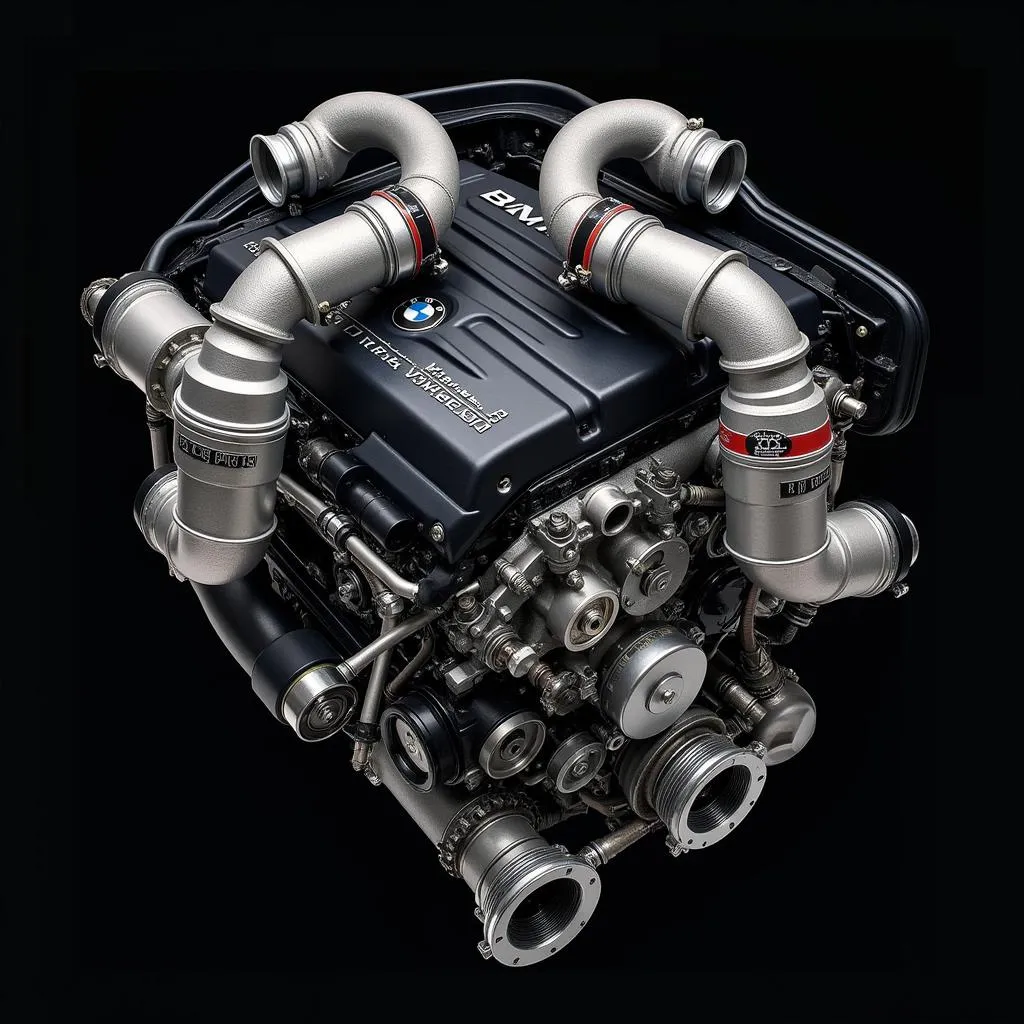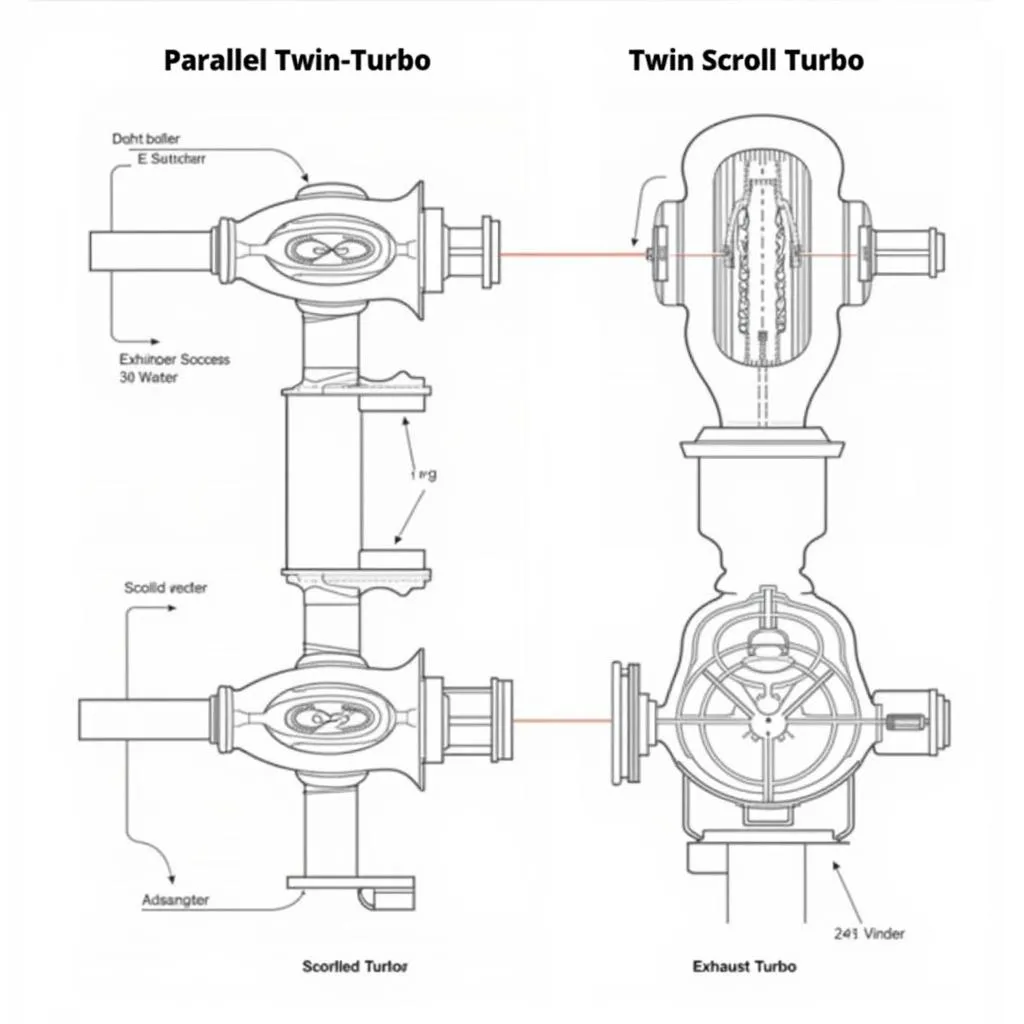Demystifying BMW Twin Turbos: Power, Efficiency, and More
BMW’s renowned twin-turbocharged engines have become synonymous with exhilarating performance and impressive fuel efficiency. But what exactly are twin turbos, how do they work their magic on BMW engines, and what are the benefits and considerations for BMW owners? This comprehensive guide delves into the fascinating world of Bmw Twin Turbos, equipping you with the knowledge to make informed decisions about your next BMW purchase or upgrade.
The Science Behind BMW Twin Turbos
At their core, turbochargers are ingenious devices that harness the often-wasted energy from a car’s exhaust gases to boost engine power. A turbocharger consists of a turbine and a compressor wheel connected by a shaft. As exhaust gases spin the turbine, the compressor forces more air into the engine’s cylinders, allowing for a more potent combustion process and significantly increased power output.
Now, imagine doubling down on this power-boosting technology. That’s precisely what BMW’s twin-turbo setup achieves. Instead of a single turbocharger, these engines employ two, working in tandem to maximize performance and efficiency.
 BMW Twin Turbo Engine
BMW Twin Turbo Engine
Types of BMW Twin Turbo Systems
BMW utilizes two primary types of twin-turbo configurations, each with unique advantages:
1. Parallel Twin Turbo
In a parallel twin-turbo system, two identical turbochargers operate independently, each feeding air to half of the engine’s cylinders. This setup is particularly effective in smaller displacement engines, minimizing turbo lag—the delay between pressing the accelerator and feeling the surge of power—and delivering a more linear power delivery.
2. Twin-Scroll Turbo
The twin-scroll turbo configuration employs a single, specially designed turbocharger with two separate exhaust gas inlets, each channeling exhaust flow from a specific group of cylinders. This design optimizes exhaust gas pulse energy, further minimizing turbo lag and enhancing low-end torque, resulting in a more responsive and efficient engine, particularly in larger displacement engines.
 Diagram of Parallel and Twin-Scroll Turbo Systems
Diagram of Parallel and Twin-Scroll Turbo Systems
Benefits of BMW Twin Turbos
The incorporation of twin-turbo technology into BMW engines offers a compelling set of benefits for drivers:
- Enhanced Power Output: This is the most evident advantage, as twin turbos force more air into the engine, resulting in a significant boost in horsepower and torque compared to naturally aspirated counterparts.
- Improved Fuel Efficiency: Surprisingly, despite the increased power, twin turbos can contribute to better fuel economy. By extracting energy from exhaust gases that would otherwise be wasted, they allow for smaller, more efficient engines to deliver comparable or even greater performance.
- Reduced Turbo Lag: Twin-turbo configurations, especially the twin-scroll design, excel in mitigating turbo lag, providing a more immediate and linear throttle response that enhances the driving experience.
Considerations for BMW Twin Turbo Owners
While the advantages of twin turbos are undeniable, ownership comes with a few considerations:
- Maintenance: Twin-turbo systems add complexity to the engine, potentially leading to higher maintenance costs compared to naturally aspirated engines. Regular servicing and adherence to BMW’s recommended maintenance schedule are crucial for optimal performance and longevity.
- Potential Issues: Like any complex mechanical system, twin turbos can be susceptible to wear and tear. Common issues include faulty wastegates, leaking seals, and damaged intercooler fins.
Popular BMW Models with Twin Turbos
Several sought-after BMW models boast the exhilarating performance of twin-turbocharged engines:
- 2007 BMW 335i 0-60: This iconic model, lauded for its potent engine, showcases the exhilarating acceleration achievable with a twin-turbo setup.
- 2007 BMW 335i Coupe Mods: Enthusiasts looking to further enhance the performance of their 335i Coupes often turn to modifications that capitalize on the potential of the twin-turbo engine.
- BMW Alpina B3 Biturbo for Sale: Those seeking an exclusive and high-performance driving experience often gravitate towards the Alpina B3 Biturbo, a testament to the pinnacle of BMW’s twin-turbo engineering.
FAQs about BMW Twin Turbos
Q: How long do BMW twin turbos last?
A: With proper maintenance, BMW twin turbos can last upwards of 100,000 miles. However, factors like driving habits, operating conditions, and adherence to service schedules significantly influence their lifespan.
Q: What are the signs of a failing BMW twin turbo?
A: Common signs of a failing twin-turbo system include a noticeable decrease in power, unusual whistling or whining noises from the engine bay, excessive smoke from the exhaust, and increased oil consumption.
Q: Can I upgrade my BMW to have twin turbos?
A: While technically possible, retrofitting a twin-turbo system onto a BMW not originally equipped with one is a complex and costly undertaking. It requires extensive modifications to the engine, exhaust system, and electronics.
 BMW Twin Turbo Maintenance
BMW Twin Turbo Maintenance
Conclusion
BMW twin turbos represent a remarkable feat of engineering, delivering a potent blend of power, efficiency, and driving excitement. Understanding their operation, benefits, and potential drawbacks empowers BMW owners and enthusiasts to make informed decisions about their vehicles. If you seek a thrilling driving experience and prioritize performance without sacrificing efficiency, a BMW with twin turbos might just be your perfect match.
For additional insights into BMW turbocharged engines, explore our article on the BMW Twin Scroll Turbo.
